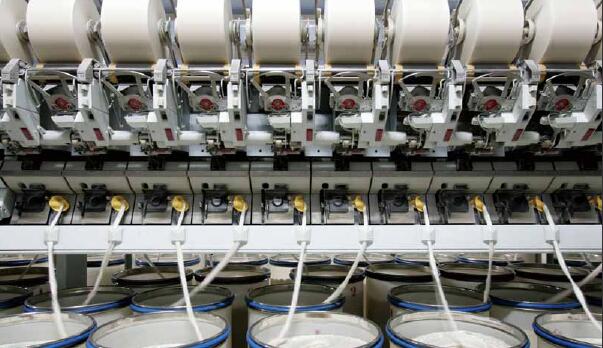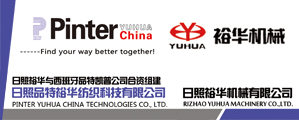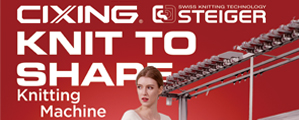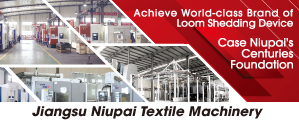The industry runs steadily and shows increasingly evident transformation
Jan 29, 2016 | by
The industry runs steadily and shows increasingly evident transformation
By Xu Yuanyuan

Since the 12th Five Year Program, China textile industry has maintained a sustained, steady and sound development with the expanding scale of industrial volume, effective implementation of science and technology, brands, sustainable development, qualified personnel and other important strategies as well as the promotion of constructing the powerful textile country strategy. However, as the great changes took place in external macro situation and internal development pattern, the economic growth of the textile industry was gradually slowing down to a moderate speed during the 12th Five Year Program compared with the high-speed period of the 10thFive Year Program and the medium-high speed period of the 11th Five Year Program, moreover, the optimization of the industrial structure and the promotion of the development quality would stimulate the economic growth prominently and the character of transforming the development stage and accelerating upgrade became increasingly obvious. Here are some characteristics that appeared in China textile industry since the start of the 12th Five Year Program.
The economic scale and benefit run steadily with a decline at growth speed
In 2014, the fiber processing volume amounted to 50 million tons in Chinese textile industry with an average annual growth rate of 4.9% compared with year 2010 and the average annual growth rate fell by 6.8 percentage points, compared with the first decade of the 21st century. The fiber processing volume in China remained steady at more than 50% of the world share. In 2014, the total export of the textile and garments was 307 billion dollars with an average annual growth rate of 9.7% and fell by 5.4 percentage points, compared with year 2001 to 2010 and the total exports accounted for 37.4% of the world and increased by 3.1 percentage points, compared with year 2010. The main business income of the enterprises ADS (above the designated size) was 6,722 billion yuan with an average annual growth rate of 10.3%, 8.5 percentage points slower than that of the first ten years (2001-2010). The total profits of the textile industry registered 366.3 billion yuan, up by 13.1% on the average(2011-2014) and declined by 9.5 percentage points, compared with the first ten years in the new century.
The industrial structure and running quality are gradually optimized
The positive progress has been made in the industrial structure adjustment of textile industry to such an extent that the fiber processing proportion of garment, household textile and industrial textile is adjusted to 46.8:28.6:24.6 in year 2014 from 51:29:20 in the year 2010. The industrial textile has played an increasingly important role as the new source of economic growth point, as indicated by the increase of 4.6 percentage points in the above cake-share. The chemical fiber accounted for 82% of the whole fiber processing volume and increased by 13 percentage points, compared with year 2010, playing a vital role in ensuring the supply of textile materials and improving the structure of the materials in the case of the short supply of the natural fiber and the differentiation rate of it was above 50% in its product portfolios. The main business income of the textile enterprises accounted for 22.5% of the whole industry and increased by 5.7 percentage points, compared with year 2010 in Middle and West areas with the gradual promotion of the regional structure adjustment at home. The multinational layout ability of the textile enterprises has ascended and the backbone enterprises tried aggressively to build up a “China + surrounding countries” pattern, starting to penetrate into high-end field of the industrial chain in developed countries.
The economy operation quality of the textile industry improved steadily, the sales profit ratio of the enterprises ADS was 5.4% in 2014 and increased by 0.5 percentage point, compared with year 2010. The turnover ratio of the total capital is 1.6 times per year and increased by 6.7%. The turnover ratio of the finished goods is 20.6 times a year and increased by 4.6%. The total fees of management, sales and finance occupied 6.2% of the main business income and declined by 0.3%. The ratio of the asset liability was 53.4% and declined by 2.6 percentage points, which reflected the gradual promotion of the enterprise profit, management and risk control abilities.
The scientific and technological innovation capacity stepped up steadily
The textile industry increased its spending on scientific and technological innovation constantly. The appropriation expenditure of the enterprises ADS on R & D accounted for 0.47% of the total main business income in 2013 and increased by 0.04 percentage point compared with year 2011, among them, the R & D on chemical fiber industry reached 0.92% and large and medium-sized enterprises which do the R & D activities accounted for 20.4% in the total number of these enterprises. The key technological innovation of the industry has made positive progress and was used widely in the industry. A batch of high-tech fiber production technologies and special equipment manufacturing has made breakthroughs, breaking the monopoly of the foreign technologies. The high-speed, automated and continuous new textile equipment was widely used that greatly improved production efficiency. As the textile processing and modern information technology is progressively integrated in the manufacturing sector, its application to the online monitoring and to the management system in comprehensive aspects was further deepened and promoted in large and medium-sized enterprises. The e-commerce has become a development window, the clothing customization technology was started to apply and the digital and intelligent technology have formed an experimental pilot.
The results of industrial science and technology emerged abundantly and the number of patent for invention of the enterprises ADS reached 7716 and 3.4 times than that of year 2010. There are 17 projects winning the state preeminent science and technology award during the 12th Five Year Program period, and “the digital and automatic technology and equipment for the cheese dyeing” won the first prize of the national scientific and technological progress, and 650 achievements won the CNTAC scientific and technological awards.
The brand building was promoted continuously
The self-owned brand awareness of the textile industry has been greatlypromoted to build up the brand value system that consists of quality, innovation, rapid response and social responsibility, etc., recognized and practiced by domestic textile clothing enterprises. The research and release on fiber and fabric fashion trend in China and the apparel award activities were widely attended and promoted by the enterprises, resulting in the gradual formation of the whole industrial brand system. The environment for developing self-owned brand improved gradually so that the brand structural pattern was formed basically, involving the national policy support, industry collaborative propulsion, the enterprises management and social organization. Besides, a package of promotional system was preliminarily set up for the brand cultivation, standard management and evaluation in the textile industry. The market recognition of the self-owned brand has improved to the effect that there are almost 3500 clothing textile brands active in the domestic market and 300 Chinese famous trademarks. The rapidly expanding textile and apparel e-commerce has promoted the market influence of the brands as is proven by the online retail sales of the clothing and home-textile, reaching 670 billion yuan in 2014, doubling that in the year 2012.
Energy conservation and emission reduction got achievements
Large numbers of energy conservation; consumption reduction and emission reduction textile processing new technologies were popularized and applied in the whole textile industry. In cotton textile sector, non-PVA environmentally-friendly sizings were used, representing more than 10% of the total sizing application. In chemical fibers sector, more than 40 technologies focusing energy conservation and emission reduction were adopted, with the wastewater recycle rate of 85% in membrane (osmosis) process technology, cleaning waste polyester bottle chips and with the online additives injection and dope dyeing technology applied to 3.3 million tons of fibers. In dyeing and printing sector, the amount of fresh water taken into the steamline declined to below 1.8 tons from 2.5 tons during the 12th Five Year Program period by generalizing cleaning and dyeing technology, making it possible for the wastewater reuse rate to rise from 15% to more than 30%. The recycled fiber products were promoted and the renewable fiber processing scale was further enlarged with the annual output 6 million tons in 2014 and increased 50% compared with 2010. The variety and quality are further enhanced in the renewables, covering, the filament, cotton, wool, non-woven and filling products, thanks to the recycling and utilizing technology that has made further progress, and to the major breakthrough in the key technology and equipment of physical and chemical way of fiber recycling. The recycling system of the waste textile products takes form in the whole value chain by recovering, sorting and comprehensive utilization. Moreover, the “worn-out clothes with zero discard” activity has promoted the recycling and reusing process of the old home textiles and clothes in a standard practice.
The important indicators of energy conservation, consumption reduction and resource recycle have turned out in gradual improvement during the 12th Five Year Program period, which witnessed a decline by 20% on energy consumption out of the added value on unit output basis , and a reduction by 20% in carbon dioxide emissions and a drop by 30% in water consumption. Referring to the recycling, the waste generated in the process of production was basically recovered for reuse and the solid waste remains at around 85% in comprehensive utilization rate,whereas,the recycled textile fibers increased in its share of the total fiber processing volume to more than 12% in 2014, compared with 9.6% in 2010.
Strengthening the effort on talent backup
During the 12th Five Year Program period, the textile industry has expanded its R &D personnel in number. On the enterprises side, there were 104,000 R&D staffs (full-time equivalent) in the enterprises ADS, an increase by 26.2% in 2014 comparing the year 2011. The research personnel of the large and medium-sized enterprises accounted for 1.8% of the annual workers in 2013. The enterprises attached importance to personnel on scientific research & product development, engineers and designers by setting up organizational departments, increasing the efforts on cultivation and bringing in top-level talents, and on cultivating in-house professional talents by ways of various educational programs in customized, entrusted courses, short-term training and self-built universities.
On the education side, there are 185 universities with majors in textile and apparel, 200 vocational colleges and 100 training schools, which provide a multi-level human resources system in the completely structural education for textile personnel development.
On the side of national textile organization, China National Textile and Apparel Council (CNTAC) granted 5000 people Science and Technology Awards, strengthening its efforts on talents promotion program by laureate innovations in textile industry and universities through the” Light of Textile” Foundation.
There are still many problems that occurred in industrial development
Although the textile industry in China has made a series of achievements, there are still attentive problems challenging the industrial development.
The obvious contradiction between supply and demand of fiber
The domestic cotton failed to realize marketization of circulation for a long time and the management measure of national storage and import quotas has reduced cotton circulation efficiency. The cotton price at home is above the international market continuously, weakening the textile enterprises’ international competitiveness. The domestic cotton has been unable to meet the demand of high-grade textile products for the declining quality, resulting in the expanded gap of the high-grade cotton supply. For the chemical fiber, there is an excessive production for ordinary grade of products periodically and structurally, leaving much room to be desired for natural fiber-like, functional and differentiated products in the future development and application.
Energy conservation and environmental protection remain arduous task
The regulatory requirement on water, atmosphere and soil protection improved continually in growing scope with law enforcements strengthened. Various standards and regulations enforced without transitional period, intensified by arduous tasks for pollution emission and reduction, pose a contradictive contrast with the capital shortage, inadequate technology and the comprehensive cost increase of the small and medium-sized textile enterprises. Some local government adopted the policy of cutting at one stroke in finishing the environmental protection index task, prohibiting the new dyeing and printing projects, limiting the development of the dyeing and printing industry.
Innovation ability needs to be upgraded
The technological innovation invested by textile enterprises needed to be strengthened because this input accounts only for less than 0.5% of the main income in the whole textile industry. The original ability in our country remains to be promoted, for the high performance fibers, tech-textile products,, high-end industrial technology for high-end equipment are still monopolized by developed countries, accordingly, the related products still needed to be imported.
As the innovation resources are relatively dispersed, efforts are to be made to coordinate and integrate these innovative factors to realize synergetic effect of the industrial innovation alliance. The self-owned brand possess insufficient original design philosophy and remains to be deepened towards the consumer market by researching and understanding fashion trends as there are still many enterprises faced with the problem of unclear paths and methods. What is more, the innovative talents shortage is an outstanding problem, leading to mismatch between supply and demand for the textile professionals needed in industrial development,which calls for further improving the personnel training mode and service system.
Industrial layout adjustment will face new problems
The domestic textile industry slowed down its speed in transferring to the Middle and West of the country, and the new growth of fixed assets investment was significantly decreased during the 11th Five Year Program period, leaving part of the construction projects stalled for restrictive reasons of market capacity, cost factors, supporting facilities, etc. It is urgent for enterprises to intensify the multinational layout required by strategic development, but the investment abroad still needs to be guided and advanced orderly because great efforts are needed to improve the adaptability to the foreign environment and culture, and to understand an increasing effect on global industrial layout in the regional free trade agreement participated by the developed countries,,
The small and medium-sized enterprises maintain prominent pressure on survival and development
The price of domestic raw material, auxiliary material, financing cost and channel fees for sales promotion were increased continually in recent years, the enterprises are still bearing the pressure of the comprehensive cost rise, posing a very outstanding issue as against the background of the “new normal” period of domestic economy that shows the market competition is more fierce and competition level escalates.. The small and medium-sized micro-enterprises lack the ability to promote development, subject to the deficiency in capital, technology, and talents, facing the more serious challenges and increasingly visible survival predicament.
Big data
Achievements during the 12th Five Year Program period
The total amount of fiber processing increased by 4.9% annually in our country and took more than 50% of the global share.
The total textile and clothing exports increased by 9.7% annually in our country and took 37.4% of the global share.
The main business income of the standard-sized enterprises increased by 10.3% annually. And the total profit increased by 13.1% annually.
The percentage of the industrial textile is 20% in 2010 and increased to 24.6% in 2014.
The amount of the invention patents about the standard-sized enterprises was 7716 in 2014 and 3.4 times that of year 2010.
The online retail turnover of the clothing and home- textile was about 670 billion yuan in 2014 and doubled year 2012.
There are 3500 clothing and home- textile brands at present and 300 “Famous Trademarks of China” in the whole industry.
During the 12th Five Year Program period, the energy consumption per unit output added value decreased by 20%, the carbon dioxide emissions fell by 20% and basically finished the compulsory task for reducing 30% of the water consumption.








